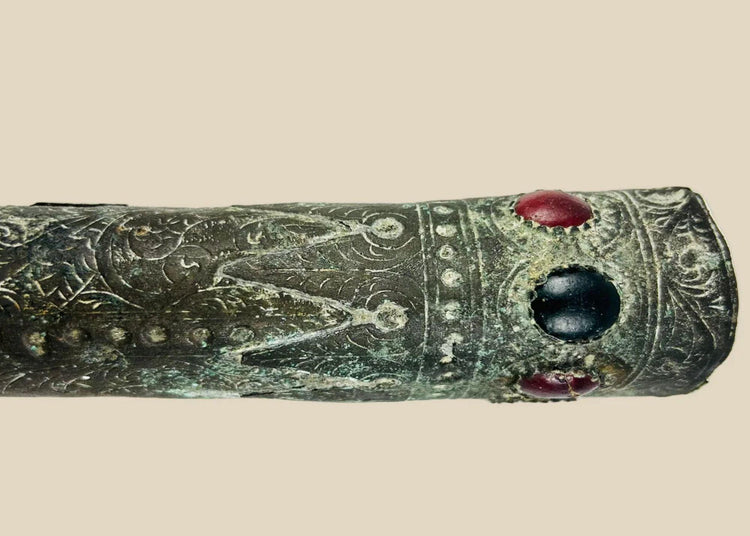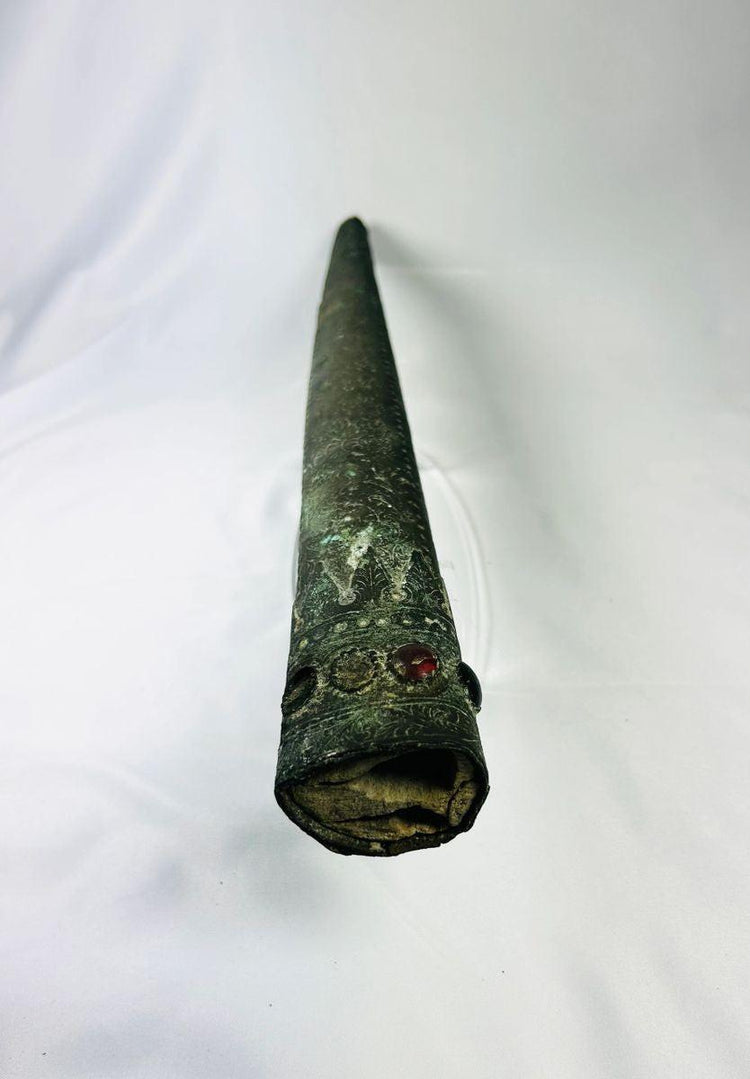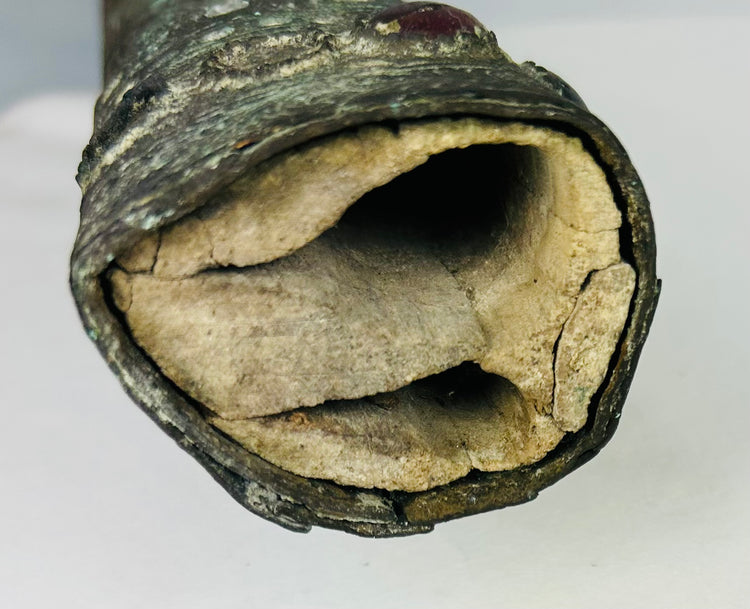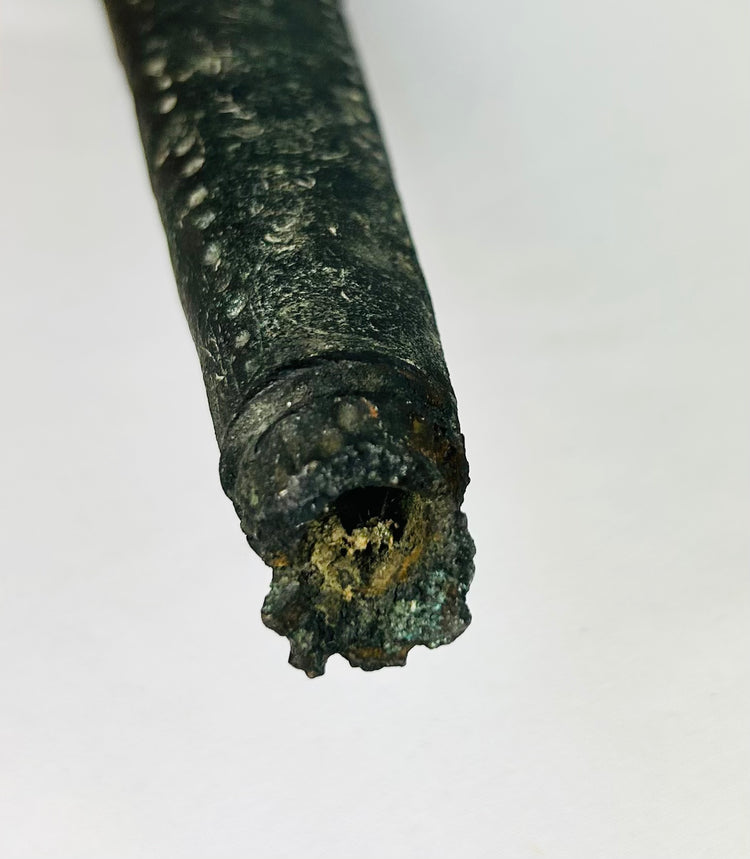Ancient Etruscan Bronze Sword Sheath | High-Status Warrior Artifact | 900–700 BC
Description
More
Less
Historical Context & Origin
Region: Etruria (modern-day Tuscany and Lazio, Italy)
Material: Bronze with gemstone inlay
Period: 900–700 BCE
Description
This exceptional Etruscan bronze sword sheath represents one of the earliest examples of fine Italic metalwork, dating to between 900 and 700 BCE. Expertly forged from bronze and intricately engraved with linear and dotted motifs, the sheath is further enhanced by inlaid gemstones in deep red and dark tones — a mark of prestige and status among early Etruscan elites.
Measuring approximately 18 inches in length, it displays a masterful balance of form and ornamentation, uniting both ceremonial and martial significance. The sheath’s rich green patina, developed over nearly three millennia, attests to its great antiquity and authenticity. Objects of this caliber were often commissioned for noble warriors or used as ceremonial offerings, symbolizing protection, valor, and divine favor.
Features
- Finely cast and engraved bronze construction
- Gemstone inlays in red and dark hues
- Linear and dotted incised decoration
- Rich natural green patina developed over centuries
- Exceptional preservation and craftsmanship
Cultural Significance
The Etruscans were among the most sophisticated civilizations of pre-Roman Italy, celebrated for their metalworking and artistic refinement. Bronze sword sheaths such as this not only served practical and ceremonial purposes but also represented personal identity, power, and divine guardianship. This piece exemplifies the Etruscans’ mastery of metallurgy and their enduring influence on early Roman art and culture.
Condition
Excellent preservation with original patina and gemstone inlays intact. Minor wear consistent with great age, enhancing its character and authenticity.
Dimensions (Approximate)
Length: 18 in
Age
900–700 BCE
Learn More & Explore
Browse our curated selection of authentic ancient blades and accoutrements in the Ancient Swords & Weaponry Collection – Relic & Rarity — a gateway to metalwork artistry, warrior culture, and historic craftsmanship.
Delve into the scholarly collection at the British Museum: Roman Bronze Sword & Scabbard (Museum No. G 1849,0518.30) — a reference-level example of early Roman weaponry preserved in a world-leading institution.
Description
Historical Context & Origin
Region: Etruria (modern-day Tuscany and Lazio, Italy)
Material: Bronze with gemstone inlay
Period: 900–700 BCE
Description
This exceptional Etruscan bronze sword sheath represents one of the earliest examples of fine Italic metalwork, dating to between 900 and 700 BCE. Expertly forged from bronze and intricately engraved with linear and dotted motifs, the sheath is further enhanced by inlaid gemstones in deep red and dark tones — a mark of prestige and status among early Etruscan elites.
Measuring approximately 18 inches in length, it displays a masterful balance of form and ornamentation, uniting both ceremonial and martial significance. The sheath’s rich green patina, developed over nearly three millennia, attests to its great antiquity and authenticity. Objects of this caliber were often commissioned for noble warriors or used as ceremonial offerings, symbolizing protection, valor, and divine favor.
Features
- Finely cast and engraved bronze construction
- Gemstone inlays in red and dark hues
- Linear and dotted incised decoration
- Rich natural green patina developed over centuries
- Exceptional preservation and craftsmanship
Cultural Significance
The Etruscans were among the most sophisticated civilizations of pre-Roman Italy, celebrated for their metalworking and artistic refinement. Bronze sword sheaths such as this not only served practical and ceremonial purposes but also represented personal identity, power, and divine guardianship. This piece exemplifies the Etruscans’ mastery of metallurgy and their enduring influence on early Roman art and culture.
Condition
Excellent preservation with original patina and gemstone inlays intact. Minor wear consistent with great age, enhancing its character and authenticity.
Dimensions (Approximate)
Length: 18 in
Age
900–700 BCE
Learn More & Explore
Browse our curated selection of authentic ancient blades and accoutrements in the Ancient Swords & Weaponry Collection – Relic & Rarity — a gateway to metalwork artistry, warrior culture, and historic craftsmanship.
Delve into the scholarly collection at the British Museum: Roman Bronze Sword & Scabbard (Museum No. G 1849,0518.30) — a reference-level example of early Roman weaponry preserved in a world-leading institution.
You May Also Like
































